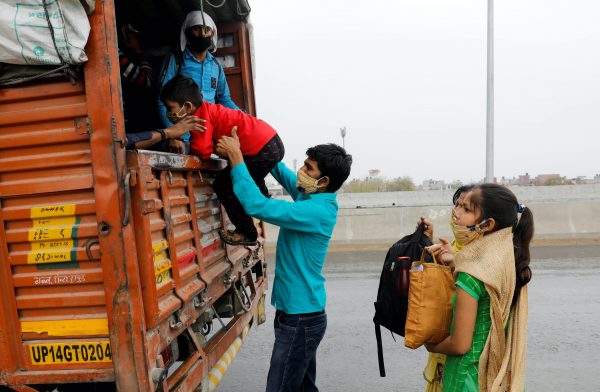Migrant workers are generally employed in the informal sector, doing unskilled jobs in textiles, manufacturing, construction, hotel transportation, services or domestic work. Migrants start working at an early age, spending their days at worksites and returning home to perilous shelters in the slums where they share small rooms with 5–6 others. They are politically invisible to urban planners because they are not enfranchised in the area where they work.
Indian roads featured a mass exodus of migrant labourers making the long journey home from their place of work between March and May 2020 after the government announced a two-month lockdown. On 20 May, Indian Finance Minister Nirmala Sitharaman said that the government wanted to help migrants but lacked the data to reach out to them. It is difficult to locate vulnerable migrant labourers among a population of 1.3 billion people.
The lack of government planning made things worse during the lockdown. The policy was a systemic failure in that it left many wage earners jobless. India could have avoided the human tragedy by extending financial relief to migrant workers during the lockdown period. Although helplines were created to provide rations to those in need, the government lacked the high-quality and up-to-date labour migration statistics needed to mount a holistic response to the vulnerabilities arising out of a lockdown of the informal sector.
Economic growth after the 1980s triggered inter-state migration in India as better economic opportunities outweighed the cost of moving. This made the ‘portability of food security benefits, healthcare and a basic social security framework’ crucial to migrant welfare. Yet the ongoing lack of official statistics prevents the provision of these long overdue benefits.
The problem could be solved by developing a countrywide self-registration process for migrant workers. This would provide the foundation for inter-state coordination on the fiscal costs of migration. A welfare scheme enabling the digital transfer of funds to workers could then be dispensed through a digital or mobile outlet. The ‘domestic remittances market, estimated to exceed Rs 1.5 [trillion] (US$20.5 billion), [could] be leveraged to enhance financial inclusion’ for migrant workers and their families.
The government should make better use of Pradhan Mantri Jan-Dhan Yojana, a financial inclusion program launched by the Indian government in 2014 to increase access to financial services. Bank accounts opened under the scheme ensure access to savings and deposit accounts, remittances, credit, insurance and pensions. Yet the scheme is plagued by duplication and verification problems that come from migrants lacking official identification.
A mobile application for the self-registration of migrant labour workers — containing their personal information, Aadhar number, place of residence and place of work — is a proposed framework for capturing much-needed data of migrant workers. Although one in four Indians have a smartphone, mobile phones are available to over 90 per cent of the population.
The M Pesa mobile payment model prevalent in African countries provides an example of how mobile platforms can be used to transfer funds to vulnerable communities. A user-friendly money transactions application based on the Unified Payments Interface — a real-time payment system developed by the National Payments Corporation of India — could be easily designed in India. The same application could be developed for smartphones and those with internet access.
Every crisis brings unique opportunities. Integration of a self-registry process with financial inclusion features in a mobile application would provide a framework for the solution to the problem of accounting and providing for the migrant labour force. Luckily, technological interventions are easy to design and maintain in India. As economic activity is restored and migrants return to work in industrial towns throughout the country, efforts to make migrant labour visible through a simple self-registry process is worth implementing.
By combining digital intervention and inter-state fiscal transfers the Indian government has an opportunity to vastly enhance the welfare of migrants, facilitate the integration of Indian labour markets and restore the faith of migrant labourers in the Indian political system.
Monika Chaudhary is Associate Professor at IIHMR University, Jaipur, and Associate Faculty at the Johns Hopkins Bloomberg School of Public Health, Johns Hopkins University.

